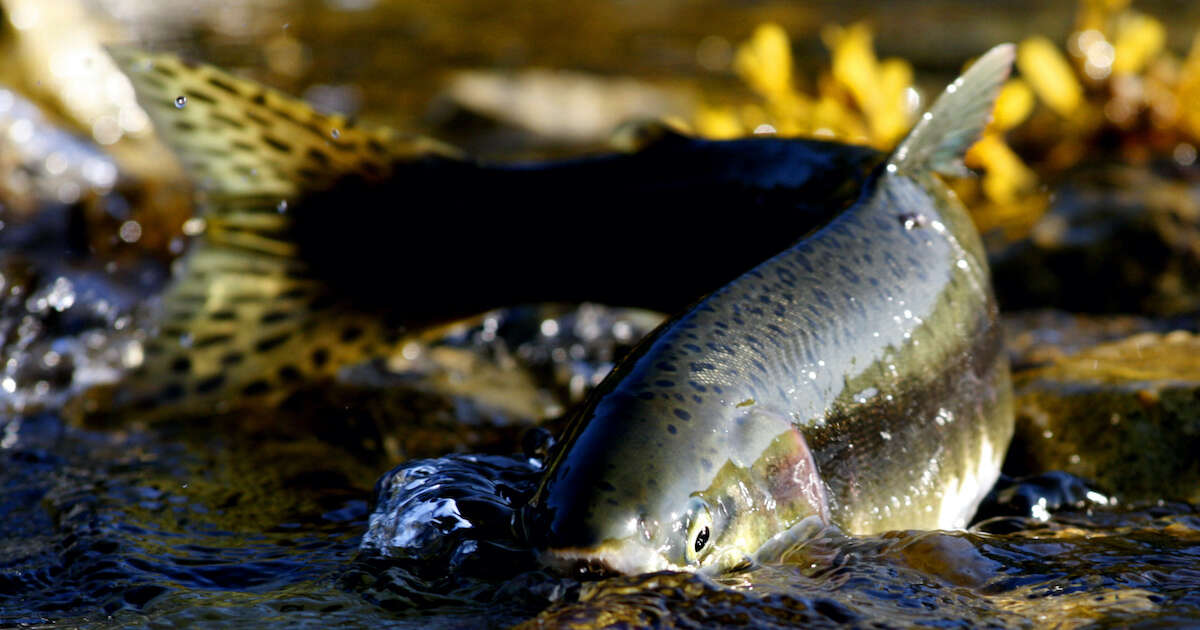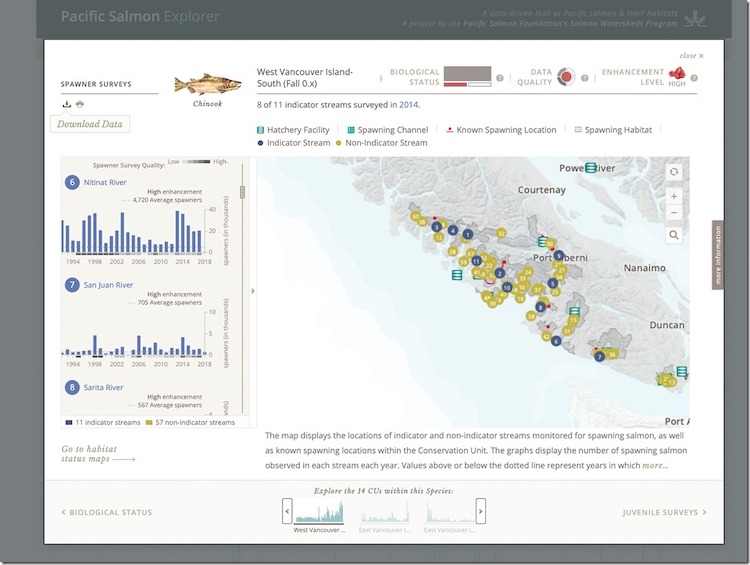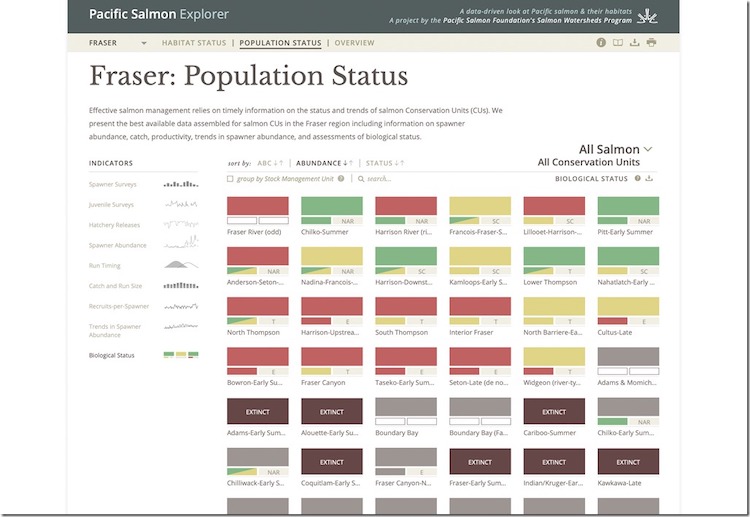
Fisheries and Oceans Canada Library
In the 1980’s, Fisheries and Oceans (DFO) published their most up to date stock assessments in documents like “The Pacific Region Salmon Stock Management Plan-Discussion Document-Chinook”. This was state of the art, but information sources like this had limitations. They only captured the history of a species up to a moment in time, and were not interactive or easy to update. To understand this more clearly think of those wonderful looking, but now obsolete, encyclopedias that many families relied upon for information and education purposes. They were nice to look at but were dated, bulky and hard to update.
Pacific Salmon Explorer
The Pacific Salmon Foundation (PSF) through its Pacific Salmon Explorer, has brought salmon data into the 21st century. The Explorer is an easy to access data visualization tool that summarizes information on salmon status and trends, including habitat, throughout BC.
PSF Watersheds Program
The genesis for this data tool, which is part of PSF’s Salmon Watersheds Program, can be traced to 2009 when the Foundation became involved in discussions on the by-catch of Steelhead in commercial sockeye fisheries on the Skeena River. The PSF’s role was to bring all interested parties to the table as a watershed governance body. In order to determine whether there was a basis for conservation concerns, the following question had to be answered: How are salmon populations in general doing in the Skeena watershed? To do this the PSF convened science experts to update and collate data on stock status, habitat issues and other potential impacts like in-river mixed stock fisheries.
By the end of the process they collected salmon data on the 55 conservation units (CUs) that make up the Skeena watershed. Conservation units (CU) are groups of wild salmon living in an area sufficiently isolated from other groups that, if extirpated, are unlikely to be re-colonized within an acceptable time frame.
Recognizing that this valuable information provided a framework for developing a centralized fish information tool, the PSF then set up a pilot data collection project for the Skeena River. This was later expanded to include the Nass River, and the watersheds of BC’s Central Coast.
Recent Updates to PSF Explorer
This most recent update to the Explorer took three years to compile the data and now includes information for the Fraser River, Vancouver Island, and the southern Mainland Inlets producing a total BC database of 3,000 salmon populations covering 339 out of 411 CUs. This represents over 80% of the CUs in BC. The work was done as a cooperative venture with DFO, First Nations, academics, and salmon experts.
This Explorer update also features assessments of data quality, interactive visuals of hatchery facilities, juvenile releases from these facilities, summaries of salmon status by species and trends for species by region. This augments elements that are already built into the Explorer like spawner abundance, productivity, salmon catch and habitat pressures. Collectively these features are consistent with and complementary to the development of comprehensive biological status and run size profiles for BC salmon populations.
Katrina Connors is the director of the Salmon Watersheds Program which includes the Pacific Salmon Explorer (PSE). She explains that, “The PSE is the first tool to bring together, and make available, the best data on salmon in BC all in one place”.

Katrina Connors, PSF Salmon Watershed Program Director
Essentially, the PSE is the science equivalent of one stop shopping. She also points out that the tool “democratizes salmon data” which means it is sourced from a wide base of interests, and is easily accessed by anyone who wants to see it.
“The explorer allows the public to see how many salmon are returning to streams each year, how many are being caught, and what human activities are potentially impacting spawning habitats.”
It also identifies salmon runs that need the most help and provides information of what factors might be limiting recovery.
PSF Explorer Usage
The database has already been used by DFO in recovery planning for Fraser River sockeye and Chinook; First Nations have used it for developing a strategic plan for BC central coast salmon conservation, and it was being used to summarize threats and identify conservation actions in the lower Fraser River.
Connors also noted that they are looking for information that salmon restoration and enhancement groups have collected, or would be willing to collect, to assist in developing a centralized database containing information on out-migrating juvenile salmon. This is something that currently does not exist. The PSF is also hoping to implement a collaborate project with the Sport Fishing Institute of BC to address information gaps for south coast Chinook salmon.
This Pacific Salmon Explorer has received financial support from DFO’s Coastal Restoration Program and the Gordon and Betty Moore Foundation. For more information about this innovative program contact Katrina Connors at kconnors@psf.ca or sign up for the PSF’s Newsletter at this link: https://salmonwatersheds.ca/subscribe/.
Visit the Store
$34.99
$34.99
Featured Catch

Joel Unickow halibut (Photo: Rob Frawley Lucky Strike Sportfishing Tofino)









